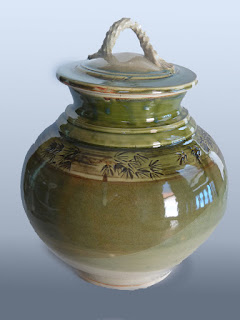As I have said before, in past posts, teapots are the test of the potter. Many variables are involved in the creation of the pieces and in the assembly of the finished pot. Handles that are functional and yet comfortable, Spouts that pour readily, lids that fit and don't fall off during the pouring process, are all involved in the creation of a finished teapot. The graphic to the right gets a little deeper into the subtleties of the teapot form.
Usually when I start doing a teapot, I throw several, bodies, spouts and lids at one time. This time I only threw four sets with a few extra spouts and lids. The extras allowed me to pick and choose what I wanted to use on the teapots design wise.
 |
| Embroidery hoops and trimmed pot body |
|
|
The body of the teapot usually starts as some form that will hold an amount of liquid, has some form of foot ring on the bottom, and an opening to pour the water into, and clean the teapot as needed. Either one large hole, or several smaller holes are added to the form during assembly to allow entrance of the tea into the spout during pouring.
For this series of pots I am going to do something a little different to the body first. I am going to cut the shoulder of the pot at and angle using an embroidery hoop to add a little fun to the form.
 |
| Embroidery hoop at slight angle |
 |
| Cut made where hoop had been |
 |
| Rotated top area 180 degrees |
 |
| Body rejoined ready for spout |
After the body has been rejoined, it is time to add the spout to the
form. The position and angle of the spout is very important in teapot
meant for use. If the end of the spout comes below the mouth of the pot,
the water will pour as the last of water is added into the pot. If the
angle of the spout is too perpendicular to the body the same happens, or
the tea starts pouring to quickly. If the angle of the spout is too
steep it is difficult to pour the last of the tea out, unless one tips
the pot beyond a comfortable angle. Some angle is needed also to help
pull the tea in the spout back into the pot when ending a pour. The
spout end should have sharper edge to cut off the last of the tea
preventing a drip-difficult.
 |
| Hack saw blade at angle |
 |
| Assembled spout, and lid waiting handles and finishing |
|
The spout is cut with a fettling knife, or in this case a hack saw blade at an angle. I usually taper the inside of the cut to make it fit the rounded form a little easier. I rest the spout up against the side of the pot in the position I want tracing the shape. Inside this area a place a series of holes @1/4 inch. Using scoring and slip or
magic water, I join the spout to the body and blend in the join using a wooden rib.
Here are the four finished teapots with pulled body handles and a variety of lid handles. White slip decoration was added on along with a few other embellishments to the decoration including some stamping and line work with a notched squeegee. The left three pots have the tilted neck section adding a little fun to the form. Second form one from the left uses a thrown lid handle with a little tilt to it. The far right put uses a rolled and decorated coil for a ring handle. The other two pots use pulled handle forms for the lids. As with any experiment with forms, the true test of what these work like will be when glazed and used to serve tea.
An extra note, on brewing tea in a teapot. There are also sorts of connoisseurs that know the way to brew and serve tea. There are others where it is sacrilege to do less pour hot water into the teapot and leave sit, boil the water in a kettle, pour the hot water out of the teapot, and pour in the recently boiled but cooled water. Then the tea is added and let to steep for a set number of minutes. I know these techniques, and forget much of the detail. I am simple, when I want tea, I want it then. I add tap water to the room temperature teapot, put it in the microwave for about 3 minutes, take it out and put in my tea bags or loose tea. Let it sit for about 2 minutes and pour the first cup, when that is gone I continue on until the tea is gone. I don't remove the bags, or the loose tea as the tea is stronger in the second or third cup and I like it that way.I'm sure there are those out there that would shun this, but I do what works for me, and at the same time don't knock it until you try it.
For those of you that are new to tea and teapots; a teapot is not a kettle, it should never be placed on an direct heat source like a range top, or open fire to boil water. Serious bodily harm happen from the thermal shock of the bursting pot.



























